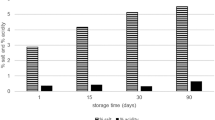Abstract
The investigation included six batches of artisan Cabrales cheese manufactured at different times of the year by two different producers and followed over a 90-day ripening period. Profound variations were found between batches due to the different mixtures of milk used from cow, goat and sheep and due to differences in temperature and humidity during ripening. Lactococci became dominant early after manufacture reaching approximately 4.0×109 cfu g−1 by day 3 and remained so throughout the ripening period. Lactobacilli remained at a lower level corresponding to about 3.2×108 cfu g−1 by day 3. Dextran-producing Leuconostoc were present in numbers of 1.0×106 to 1.0×107 cfu g−1. Large populations of coliforms (\( \approx \)1×107 cfu g−1), enterococci (\( \approx \)1×106 cfu g−1) and staphylococci (\( \approx \)1×106 cfu g−1) were present throughout manufacture in all batches, but only the latter continued to grow during ripening, and mostly on the surface (up to 1.6×107 cfu g−1). Filamentous fungi, among which P. roqueforti was a majority, reached their maximum (around 5.0×108 cfu g−1) between day 15 and day 30. By molecular methods, all lactococcal isolates were identified as Lactococcus lactis subsp. lactis. Fifty two percent of the lactobacilli were classified as Lactobacillus plantarum or Lactobacillus paraplantarum and a further 27% as Lactobacillus casei or Lactobacillus paracasei. Dextran-producing Leuconostoc mesenteroides (58%), Leuconostoc citreum (24%) and Leuconostoc pseudomesenteroides (12.5%) were identified from the MSE agar plates, although strains of non-producing Leuconostoc lactis were also isolated from MRS.
Similar content being viewed by others
References
Núñez M (1978) J Dairy Res 45:501–508
Alonso L, Juárez M, Ramos M, Martín-Álvarez PJ (1987) Z Lebens Unter Forsch 185:481–486
Alonso L, Fontecha J, Juárez M (1999) J Chromatogr Sci 37:108–112
Núñez M, Medina M (1979) Lait 59:497–513
Núñez M, Medina M (1980) Lait 60:171–183
Nuñez M, Medina M, Gaya P, Dias-Amado C (1981) Lait 61:62–79
Flórez AB, Ruas-Madiedo P, Alonso L, Mayo B (2005) Eur Food Res Technol DOI: 10.1007/s00217-005-0021-2
Limsowtin GKY, Powel IB, Parente E (1995). In: Cogan TM, Accolas JP (eds) Dairy starter cultures. VCH, New York, pp 101–130
Anonymous (1985) Milk and Milk Products. Methods of Sampling, FIL-IDF Standard 50B
Anonymous (1982) Cheese and processed cheese. Determination of the total solids content (Reference method), FIL-IDF Standard 4A
Anonymous (1987) Milk, cream and evaporated milk. Determination of total solids content (Reference method), FIL-IDF Standard 21B
Anonymous (1984) Determination of the pH of the serum. Potentiometric method, FIL-IDF Standard104A
Anonymous (1988) Cheese and processed cheese products. Determination of the chloride content. Potentiometric titration method, FIL-IDF Standard 88A
Mayo B, Hardisson C, Braña AF (1990) J Dairy Res 57:125–134
Benkerroum N, Misbah M, Sandine WW, Elaraki AT (1993) Appl Environ Microbiol 59:607–609
Priest F, Austin B (1995) In: Priest F, Austin B (eds) Modern bacterial taxonomy, 2nd edn. Chapman and Hall, London, pp 14–49
Ward L, Brown J, Graham D (1998) FEMS Microbiol Lett 166:15–21
Young JPW, Downer HL, Eardly BD (1991) J Bacteriol 173:2271–2277
Altschul SF, Madden TL, Schäffer AA, Zhang J, Zhang Z, Miller W, Lipman DJ (1997) Nucleic Acids Res 25:3389–3402
Stackebrandt E, Goebel BM (1994) Int J Syst Bacteriol 44:846–849
González de Llano D, Ramos M, Rodríguez A, Montilla A, Juárez M (1992) Int Dairy J 2:121–135
Gobbetti M, Burzigotti R, Smacchi E, Corsetti A, Angelis M (1998) Int Dairy J 7:519–529
Fontecha J, Peláez C, Juárez M, Requena T, Gómez C, Ramos M (1990) J Dairy Sci 73:1150–1157
Tornadijo ME, Fresno JM, Bernardo A, Martín Sarmiento A, Carballo J (1995) Lait 75:551–570
Cuesta P, Fernández-García E, González de Llano D, Montilla A, Rodríguez A (1996) J Dairy Sci 79:1693–1698
Devriese LA, Pot B, van Damme L, Kersters K, Haesebrouck F (1995) Int J Food Microbiol 26:187–197
Devoyod JJ, Muller M (1969) Lait 49:369–99
Klijn N, Weerkamp AH, de Vos WM (1995) Appl Environ Microbiol 61:788–792
Weerkamp AH, Klijn N, Neeter R, Smit G (1996) Neth Milk Dairy J 50:319–332
Cogan TM, Barbosa M, Beuvier E, Bianchi-Salvadori S, Cocconcelli PS, Fernandes I, Gómez J, Gómez R, Kalantzopoulos G, Lledda A, Medina M, Rea MC, Rodríguez E (1997) J Dairy Res 64:409–421
Centeno JA, Cepeda A, Rodríguez-Otero JL (1996) Int Dairy J 6:65–78
Beresford TP, Fitzsimons NA, Brennan NL, Cogan TM (2001) Int Dairy J 11:259–274
Crow V, Curry B, Hayesm M (2001) Int Dairy J 11:75–283
Pérez-Elortondo FJ, Aldámiz Echobarria P, Albisu M, Barcina Y (1998) Int Dairy J 8:725–732
Acknowledgements
This work was supported by a research project from the Spanish Ministerio de Ciencia y Tecnología (reference PTR1995-0556-OP). The authors thank the Consejo Regulador de la Denominación de Origen Queso de Cabrales for their financial and organisational support. The skilful technical assistance of M. J. González is greatly acknowledged
Author information
Authors and Affiliations
Corresponding author
Rights and permissions
About this article
Cite this article
Flórez, A.B., López-Díaz, T.M., Álvarez-Martín, P. et al. Microbial characterisation of the traditional Spanish blue-veined Cabrales cheese: identification of dominant lactic acid bacteria. Eur Food Res Technol 223, 503–508 (2006). https://doi.org/10.1007/s00217-005-0230-8
Received:
Revised:
Accepted:
Published:
Issue Date:
DOI: https://doi.org/10.1007/s00217-005-0230-8




